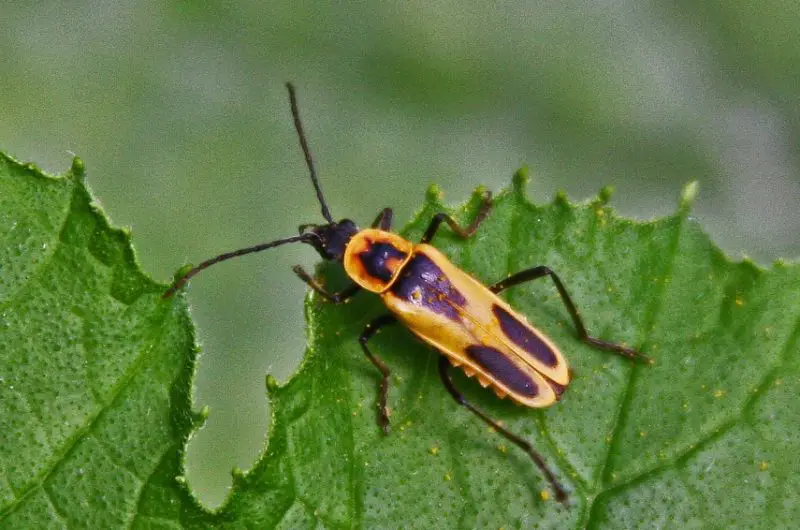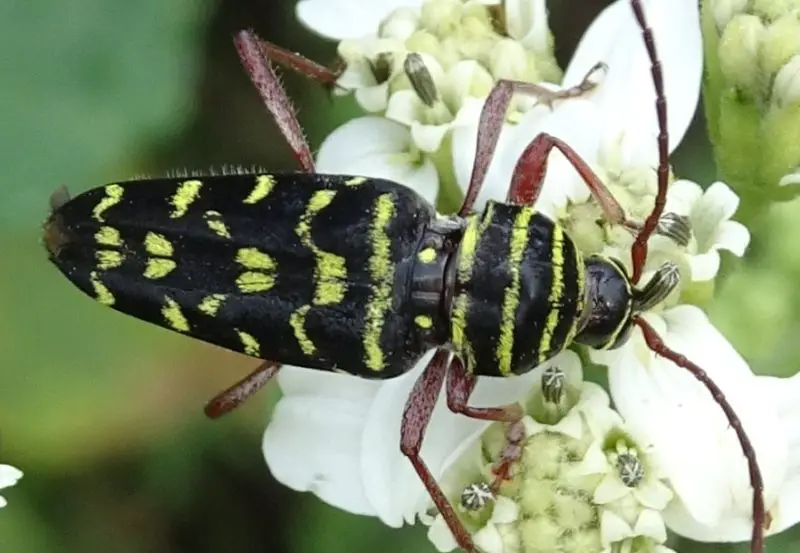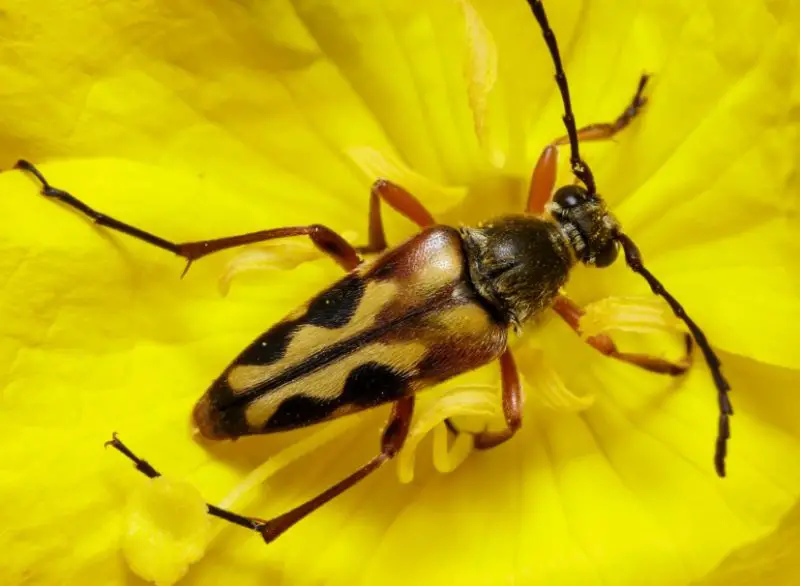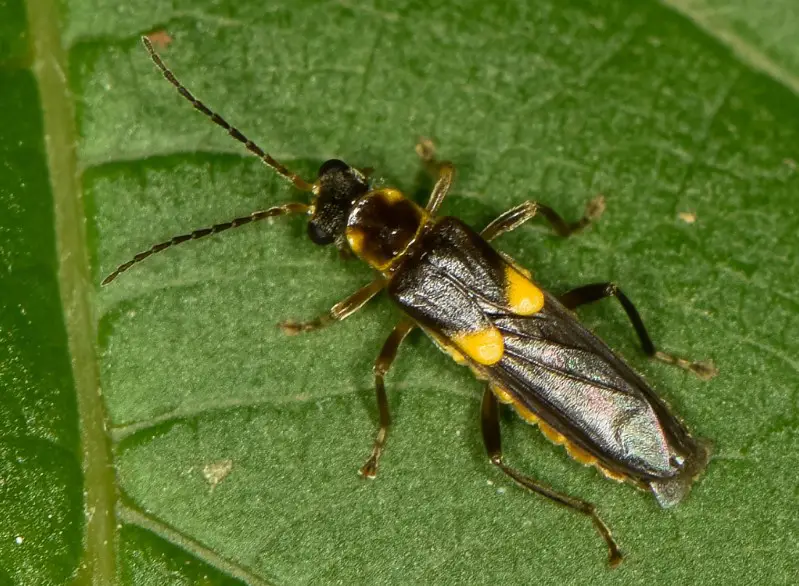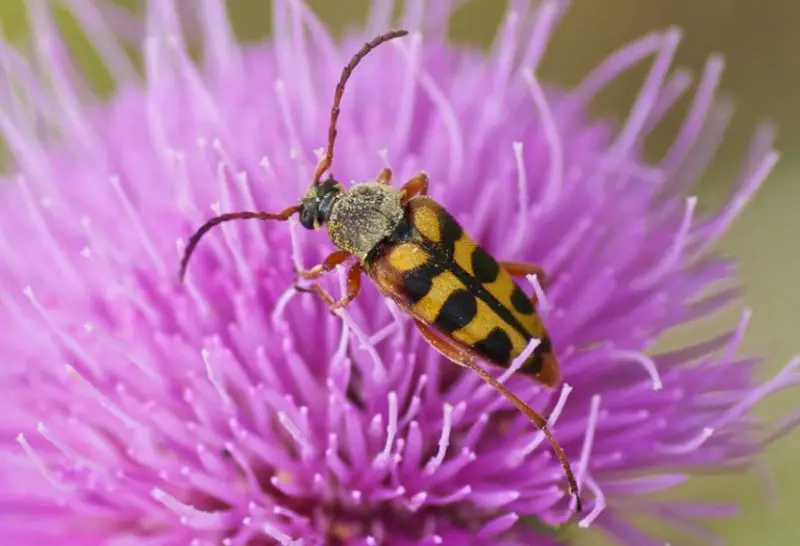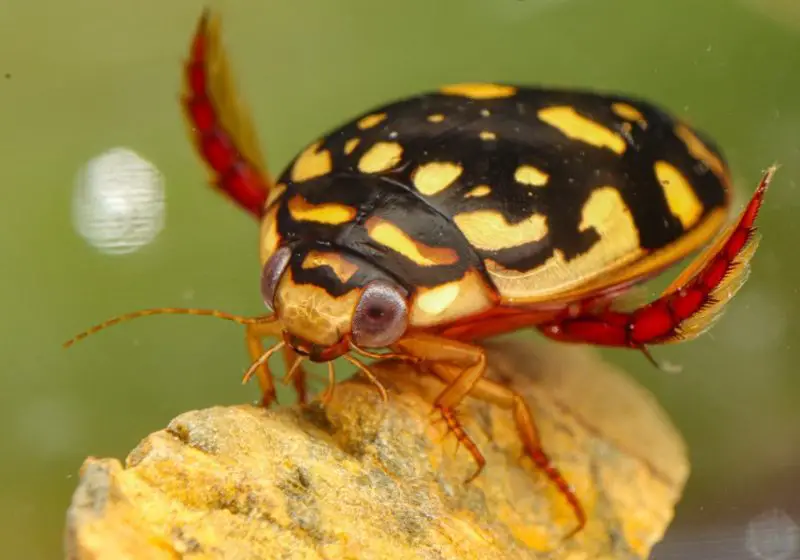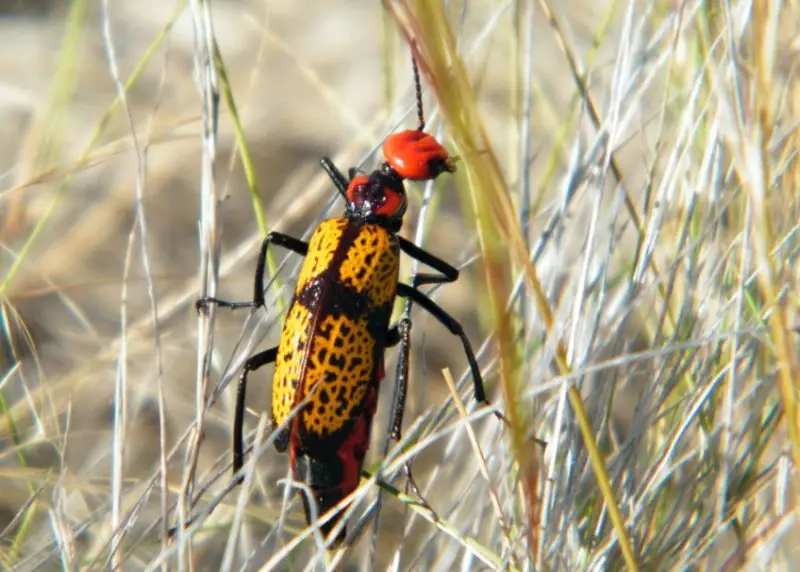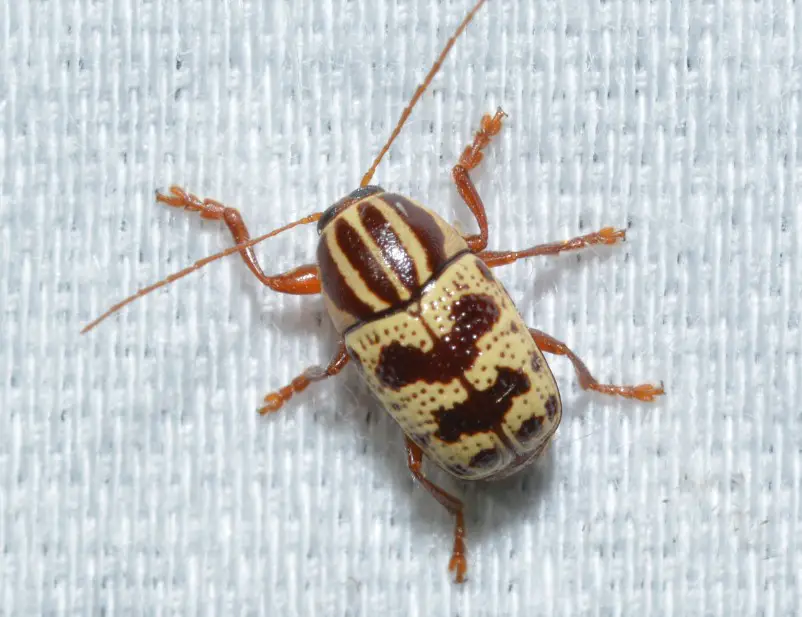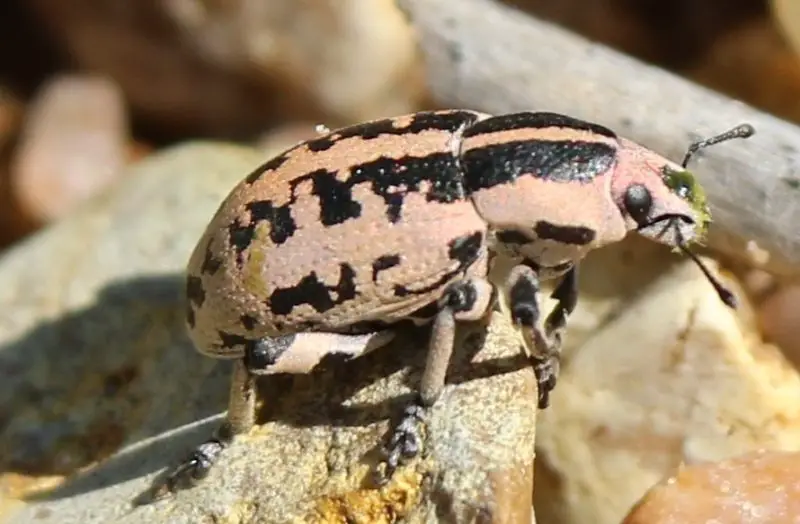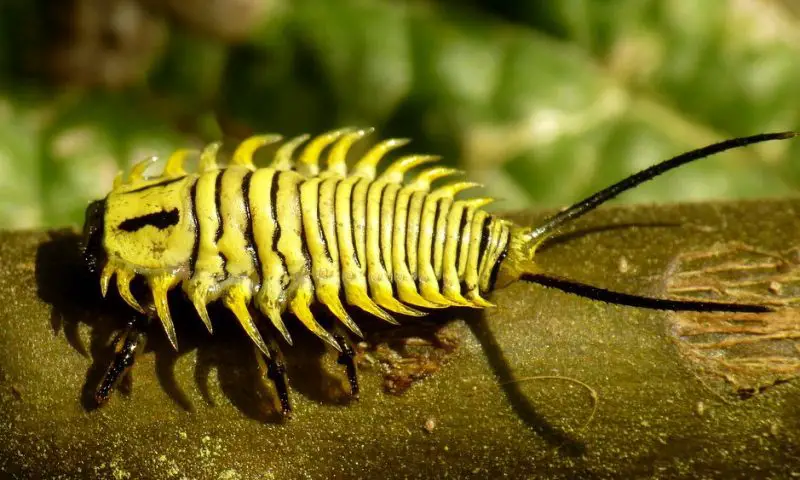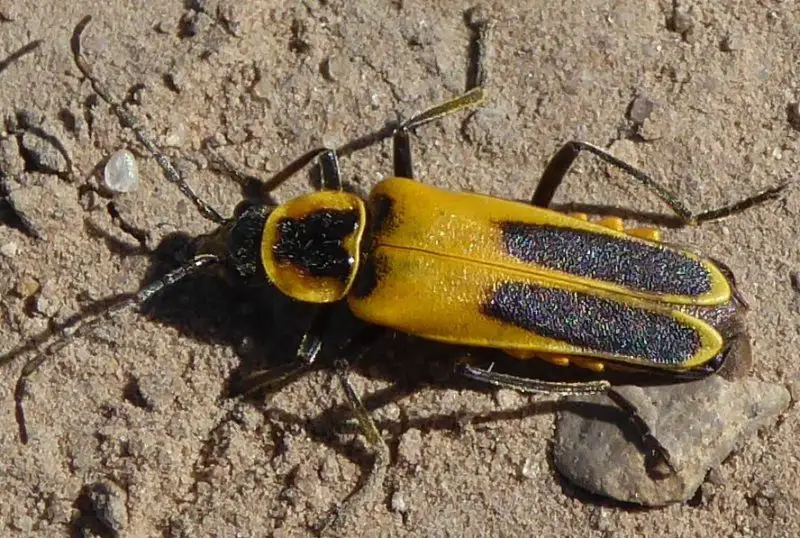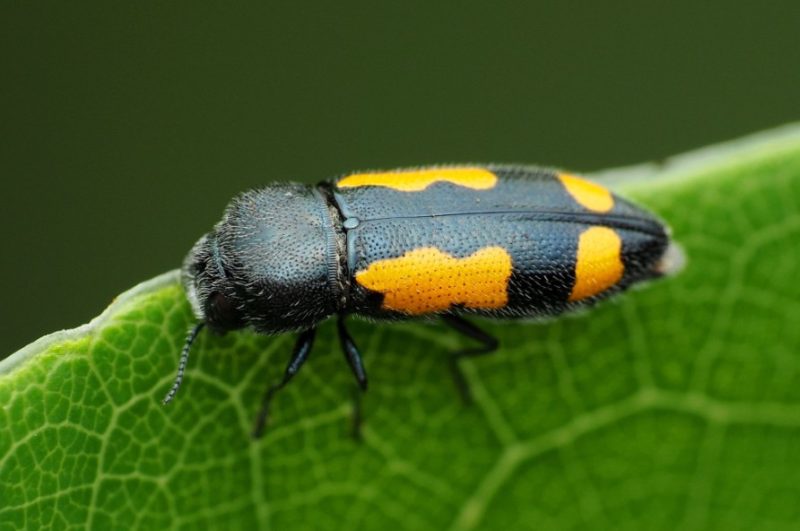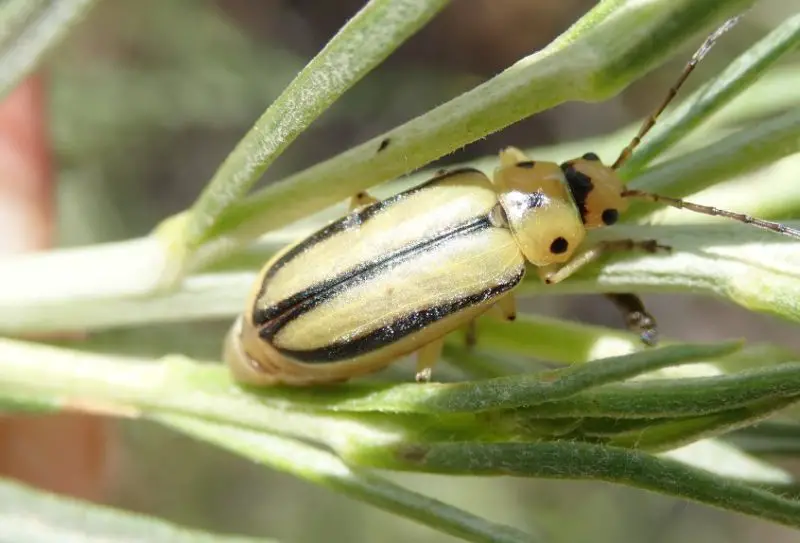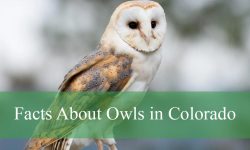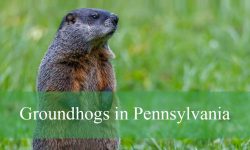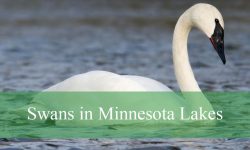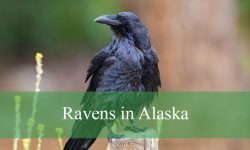The rabbitbrush beetle (Trirhabda nitidicollis), found across Western US regions, displays distinct black and yellow stripes on its pale yellow elytra. Its head features a darker yellow hue. Beneficial in areas where aster species like rabbitbrush hinder plant growth, these beetles help control such weeds, benefiting crops and native plants. Despite their benefits, managing their populations is advised, as they can also feed on other plants.
Strophiona Tigrina
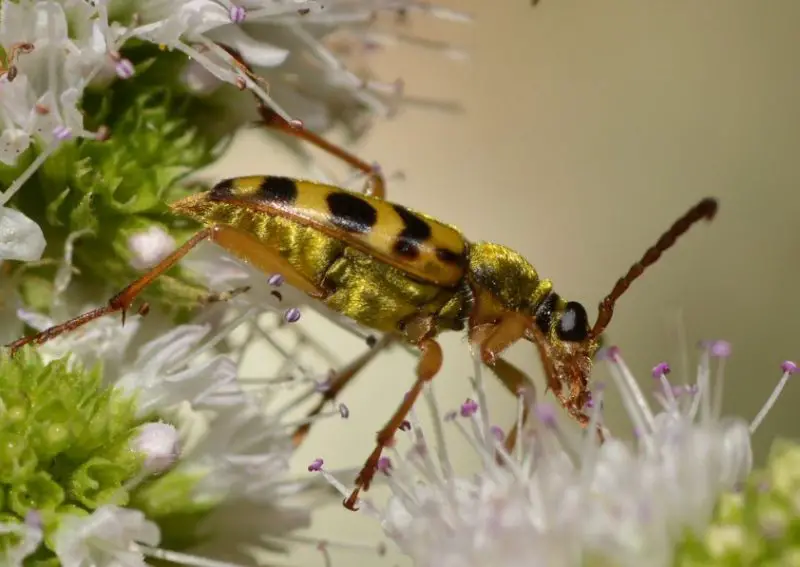
Strophiona tigrina beetles display vivid black and yellow contrast in their coloring, with a black base and irregular yellow patterns on the elytra. They mimic wasps due to their coloration, despite being flightless and feeding on pollen and nectar from various wildflowers, especially white blooms. These beetles are often mistaken for wasps, but they lack the ability to fly. Their natural predators include parasitoid wasps, which help regulate their populations in the ecosystems where they are found.
Acmaeodera Amplicollis

Acmaeodera amplicollis beetles are characterized by their black and yellow coloration, blending seamlessly with the plants they feed on in North America, such as desert marigolds and crownbeards. They have a wide black body with irregular orange marks and stripes on their elytra. Their wings feature small perforations, enhancing their camouflage among yellow flower buds. This species is adapted to mimicry, utilizing its coloration and wing features to blend into its floral habitat effectively.
Banded Ash Borer

Banded Ash Borers (Neoclytus caprea) are yellow beetles with black spots that bore into the sap of ash trees, especially dead ones. They are commonly found in stored ash logs during the winter. Although they primarily target ash wood, they also infest elm and white oak. Recognizable by their uniform black body with yellow stripes on the elytra, these beetles lay eggs under the bark of dead ash trees without harming live trees. Their underbelly features alternate black and yellow stripes, resembling wasps.
Western Corn Rootworm Beetle
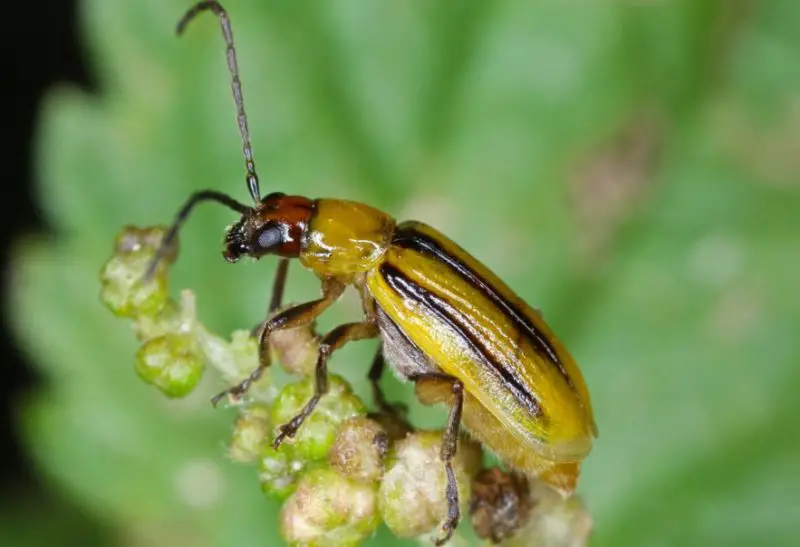
Western Corn Rootworm Beetles (Diabrotica virgifera) pose a significant threat to corn crops in Western states. Adults feed on corn leaves and kernels, causing minimal damage. However, it’s the larvae that wreak havoc by feeding on corn roots, stunting growth, and potentially killing the plants. Farmers often resort to insecticides to control these black and yellow pests. Additionally, crop rotation helps disrupt their life cycle as the eggs overwinter in the soil, hatching in spring to target young corn roots anew.
Spruce Zebra Beetle
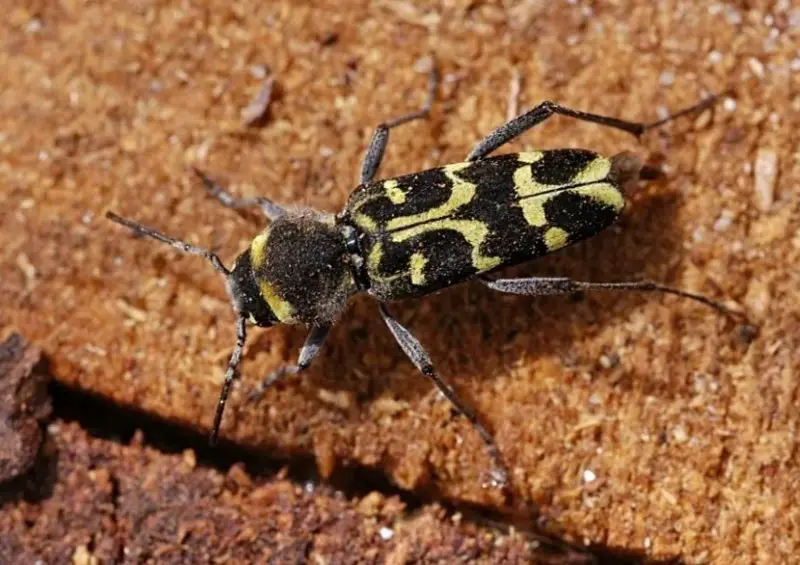
The Spruce Zebra beetle (Xylotrechus undulatus) thrives in North American woodlands, particularly on spruce and conifers at higher altitudes. Unlike other black and yellow beetles, they do not require direct sunlight. These beetles feed on the trees and lay eggs in conifer bark. They are identified by their black bodies with yellow stripes behind the head and across the elytra. Their presence indicates healthy coniferous ecosystems in forested regions.
Arizona Net-Winged Beetle
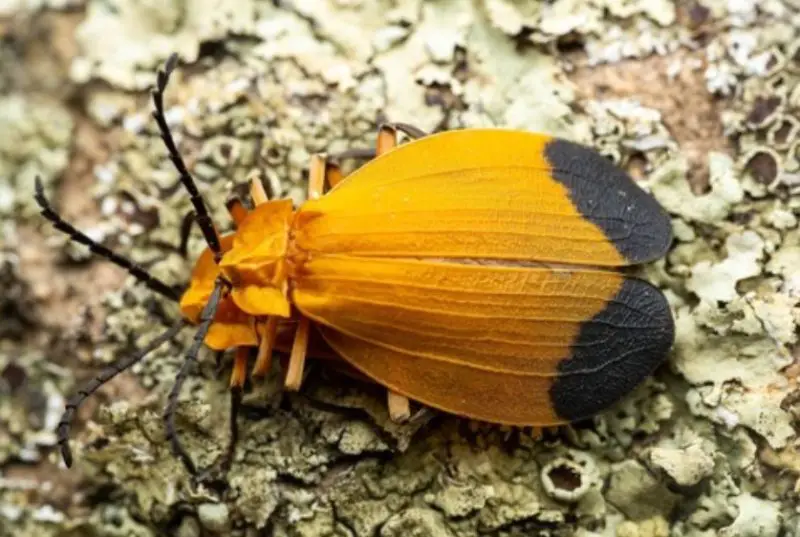
The Arizona Net-winged beetle (Lycus arizonensis) is a distinctive net-winged beetle found in the southwestern United States. It has a triangular body with large yellow-orange wings and a black head. These beetles often resemble flowers they visit, with vivid coloring that aids in camouflage. While some feed on nectar, many adults do not feed at all, living short lives. They prefer open areas abundant with flowers, typical of their native Southwestern habitats.
Festive Diabrotica
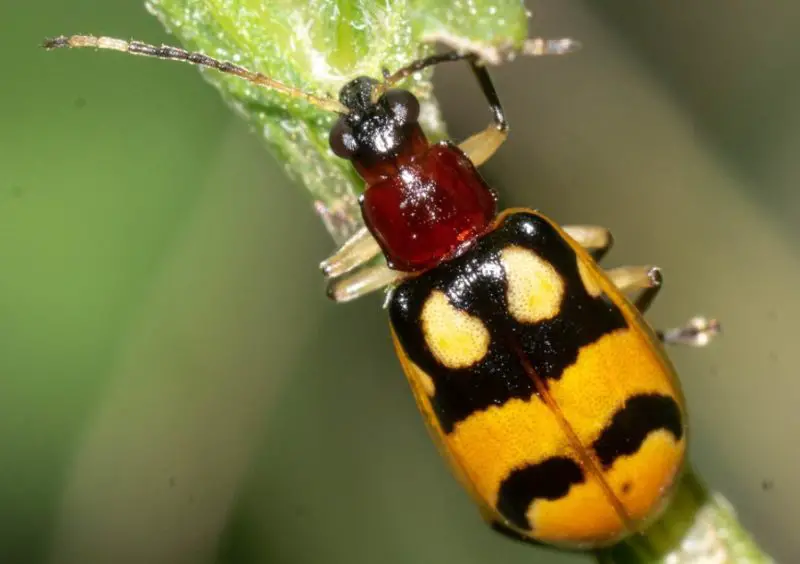
The Festive Diabrotica beetle (Diabrotica adelpha), common in Texas, features a yellow-dominant body with black markings on its elytra and a distinctive red head. Growing up to 7.4 mm, these beetles emerge in May and are exclusive to Texas and southern Mexico. They are known for their vibrant appearance and are often found in agricultural settings, where they can impact crops during their feeding stages.
Acmaeodera Alicia
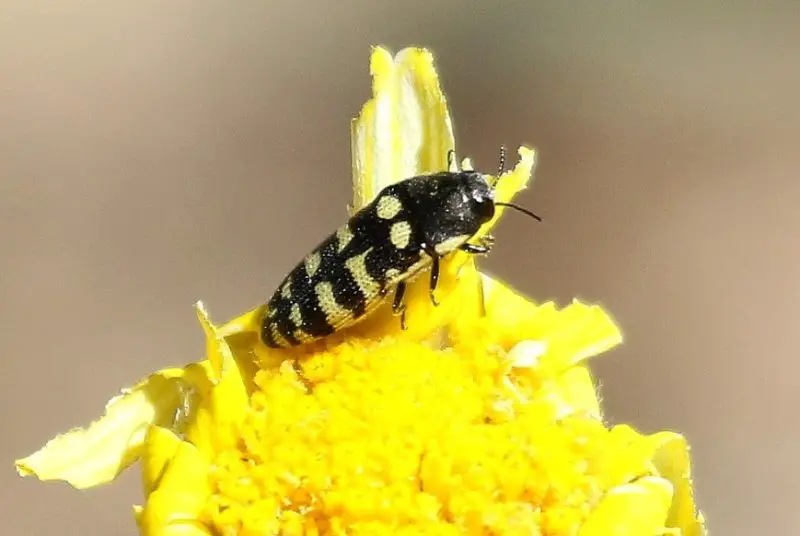
Acmaeodera alicia, found in Southwestern US states, displays black and yellow coloring and feeds on small green leaves like those of the aster family. Their ovoid shape features a black body with yellow marks and stripes. Larvae consume various parts of acacia plants. Some beetles also feed on cactus pollen or nectar. Their natural habitat spans from California to Arizona, where they play a role in pollination and plant interactions.
Acmaeodera Solitaria
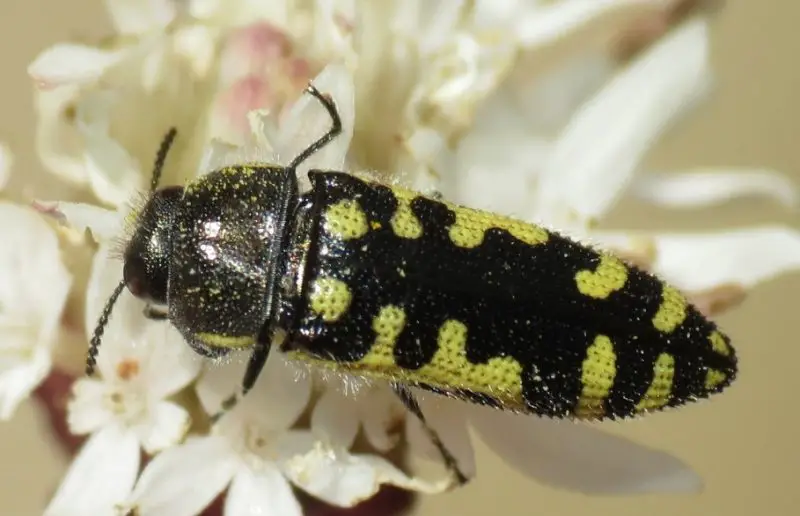
Acmaeodera solitaria, found in southwestern US states, features a black body with distinct yellow stripes. Its elongated form is marked by interrupted yellow stripes on the elytra. More prevalent in Central America than North America, this beetle lays eggs in freshly dead hardwood, contributing to the decomposition process in forest ecosystems.
Typocerus Lunulatus
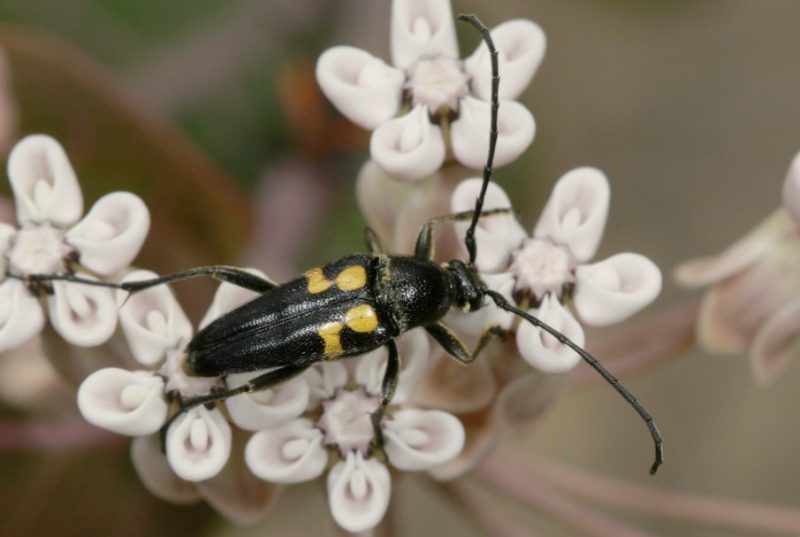
Typocerus lunulatus, black and yellow beetles ranging from 8 to 12 mm, display wide orange bands on their elytra. Their larvae exhibit an unusual diet, consuming decaying pine, contributing minimally to natural recycling processes. As adults, they shift to feeding on pollen and nectar. High populations of Typocerus lunulatus are found in states like California, Texas, and Florida, where their distinctive coloration helps them blend into various habitats rich in pine and other flowering plants.
Globemallow Leaf Beetle

Globemallow leaf beetles (Calligrapha serpentina) are prevalent in California and Texas, feeding exclusively on globemallow plants. They exhibit various morphs, all featuring black base coloring with different colored stripes and marks—commonly yellow, green, orange, or red. Larvae transition in color from red to red-brown as they mature. Despite variations in color, all morphs maintain consistent stripe and mark patterns, distinguishing them as Globemallow Leaf beetles across their habitat range.
Systena Gracilenta
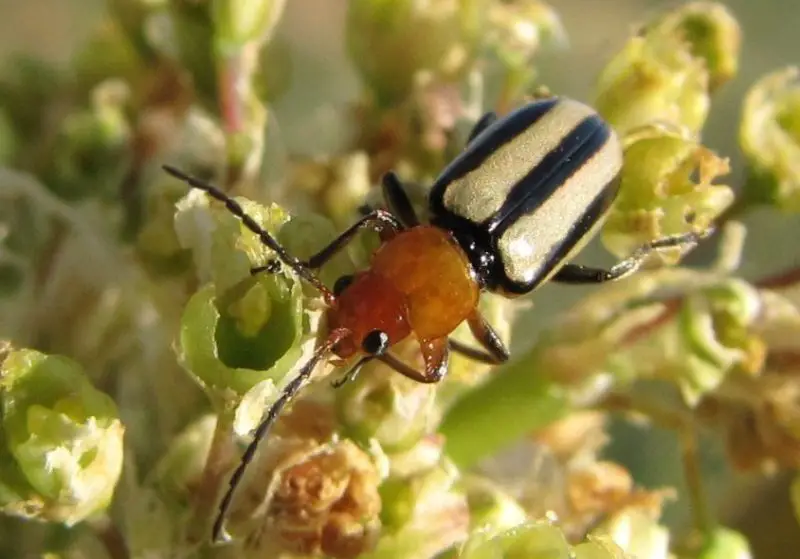
Systena gracilenta beetles are native to the Southern US and Northern Mexico and are often found on Baccharis shrubs of the Aster family. Identified by the vertical pale yellow and black stripes on their elytra, they sport an orange-brown head. Common along Texas’ Devil’s River, they are active from May to August, contributing to the local ecosystem by feeding on Baccharis shrubs, aiding in their control and management.
Amorpha Borer
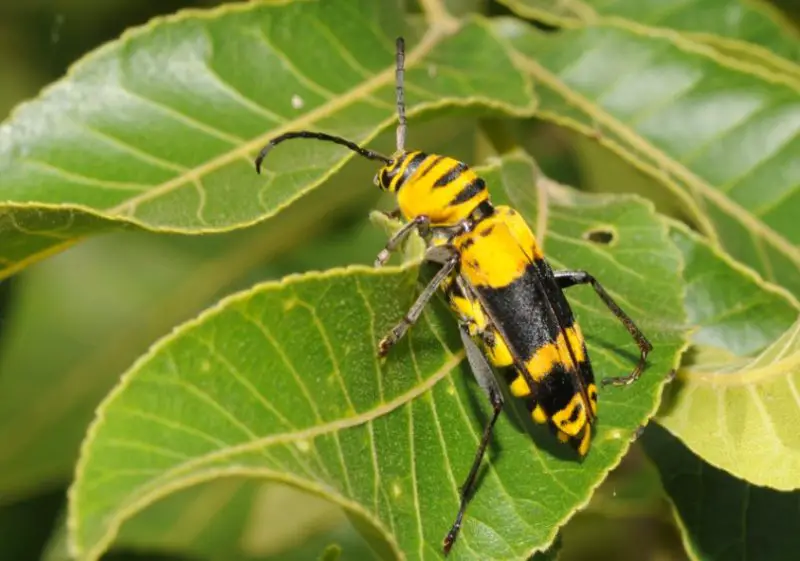
The Amorpha Borer (Megacyllene decora), found in North America where Indigo-bush plants grow, displays a striped black and yellow body. Active from June to October, it features yellow stripes on a predominantly black body, with variations in stripe width. Seen on Desert False Indigo and other yellow and white flowers, this borer contributes to ecosystem balance by feeding on various plants, including goldenrods, aiding in pollination and plant diversity.
Yerba Santa Beetle
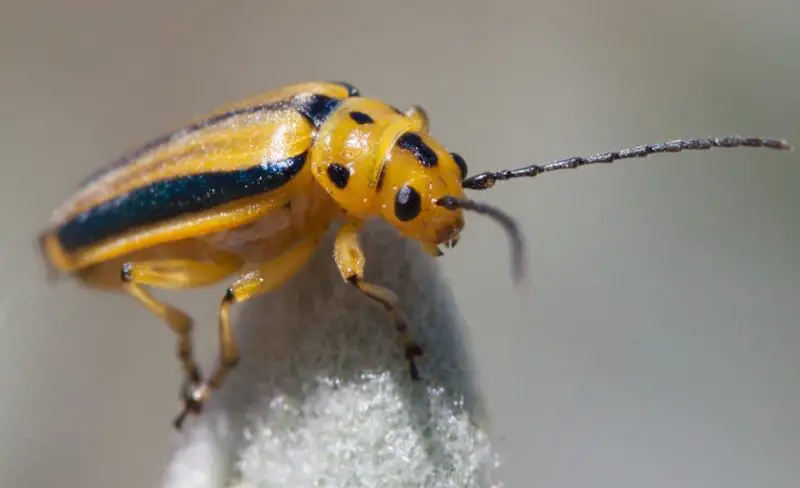
The Yerba Santa Beetle (Trirhabda eriodictyonis) is recognizable by its black and yellow striped body and yellow head with four black spots. Its pale yellow color differs from that of other vividly colored species. Herbivorous larvae appear metallic green, distinct from adults. Found on Yerba Santa (Eriodictyon crassifolium) in California and Baja California, this beetle prefers dry slopes with the plant’s broad leaves and flower buds, where it feeds and completes its life cycle.
Spotted Cucumber Beetle
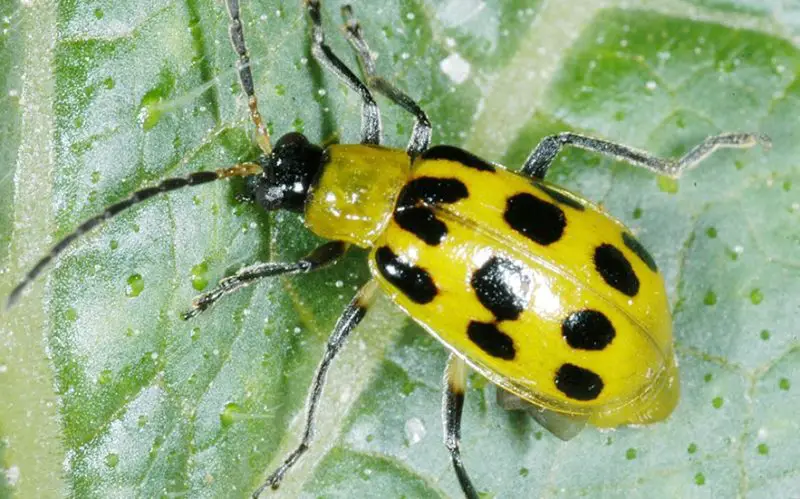
Spotted cucumber beetles (Diabrotica undecimpunctata) are prevalent black and yellow beetles in North America, known for damaging cucumber plants. Identifiable by their 12 black spots on yellow or yellow-green elytra, they blend with cucumber leaves. These pests feed on cucumber foliage, often killing the plant. Resilient, they can overwinter in the soil, emerging the next year to continue their life cycle.
Locust Borer
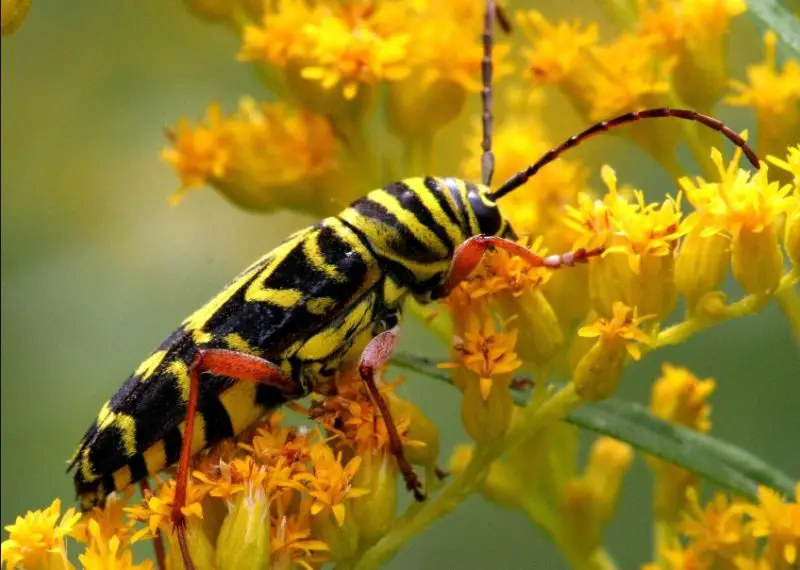
Locust Borers (Megacyllene robiniae) are black and yellow beetles resembling bees. They have a black body with W-shaped yellow marks on their elytra. These beetles can grow up to 28 mm, with antennae up to one-third of their body length. Males have longer antennae than females, whose antennae are 1.5 times their body length. They often inhabit goldenrods, matching the plant’s colors.
Eastern Hercules Beetle

The Eastern Hercules Beetles (Dynastes tityus) are among the largest yellow beetles with black spots in the US, reaching up to 7 inches in length. They have yellow elytra with black spots and can also be green and black. These beetles feed on rotting materials like fruit and wood. They are most commonly seen in the summer when females lay eggs in the ground. Their feces can measure up to 4 inches.
Ornate Checkered Beetle

Ornate Checkered Beetles (Trichodes ornatus) feature black and yellow coloring, with yellow stripes on their black elytra and short yellow hairs on their black legs. They often resemble the yellow flowers they visit for pollen, like yarrow. Males reach up to 11 mm, while females grow up to 15 mm. Their larvae are parasitic, feeding on bees by laying eggs near them.
Fourteen-Spotted Lady Beetle
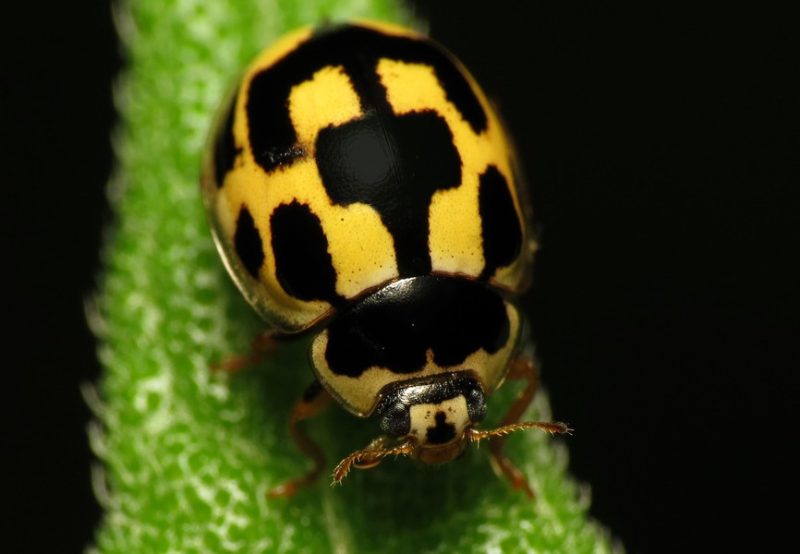
The fourteen-spotted lady beetle (Propylea quatuordecimpunctata) has a distinctive black and yellow dome-shaped body with alternating black and yellow spots on the elytra and head. Despite its friendly appearance, it is a predatory species that is highly effective at controlling aphid populations. These beetles are used commercially against wheat aphids, as both adult males and females consume these pests, benefiting crops, gardens, and greenhouses.
Delta Flower Scarab
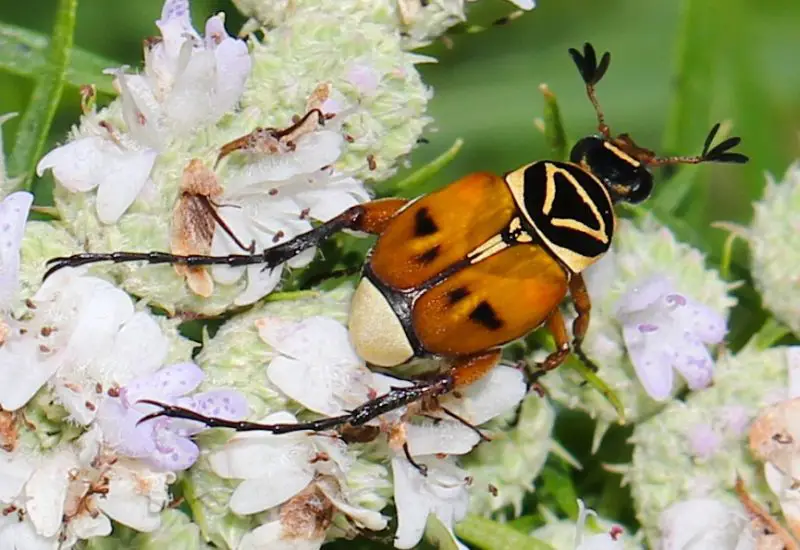
The Delta Flower Scarab (Trigonopeltastes delta) is a yellow beetle with black spots that mimics wasps with a distinct delta-shaped yellow mark. Its pronotum is black and yellow, while the rectangular elytra are mostly brown or orange-brown. Unique for its rectangular elytra, this beetle feeds on nectar and is native to the US, predominantly found in the Eastern regions.
Striped Cucumber Beetle
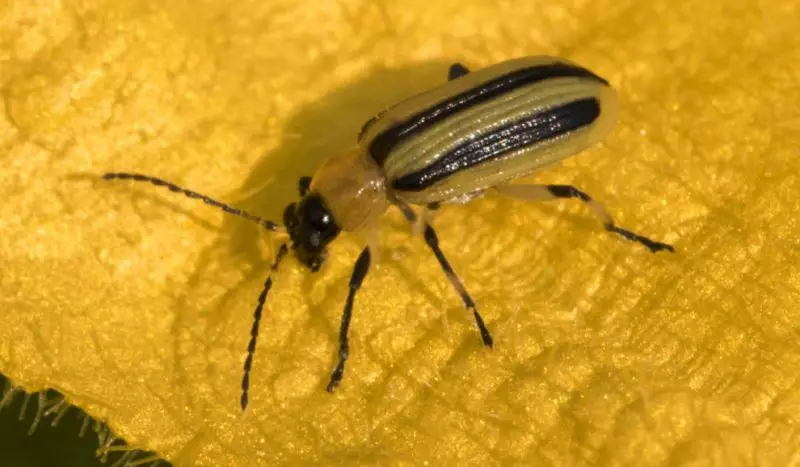
Striped cucumber beetles (Acalymma vittatum) have alternating black and yellow stripes on their body and head. These beetles pose a significant threat to cucumber crops by consuming the foliage, causing leaves to lose vigor and shape. Attracted to the smell of cucumbers, they often infest new crops. The most effective control method for striped cucumber beetles is the use of pesticides.
Colorado Potato Beetle
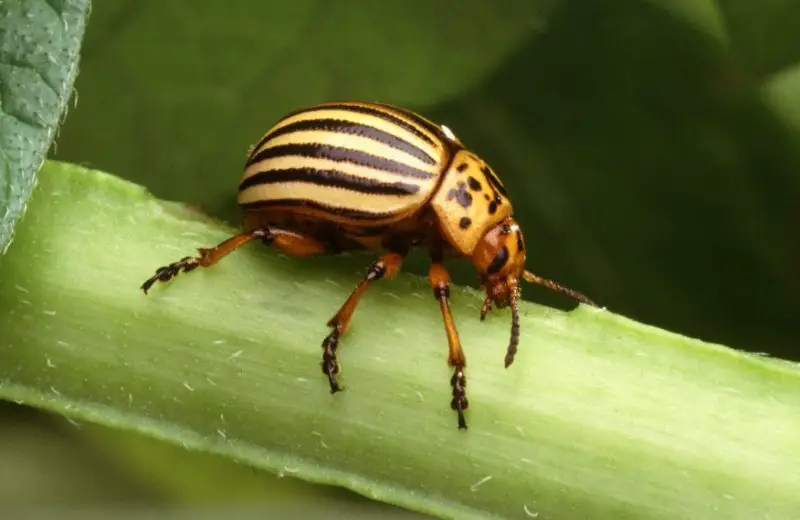
Colorado Potato Beetles (Leptinotarsa decemlineata) are invasive beetles with pale yellow and black striped elytra, growing up to 11 mm. Native to the US, they are commonly found on buffalo-bur and are notorious pests of potatoes worldwide. Due to their rapid multiplication, pesticides are often necessary for control. These beetles do not bite and can be hand-picked on small potato plantations.
Three-Lined Potato Beetle
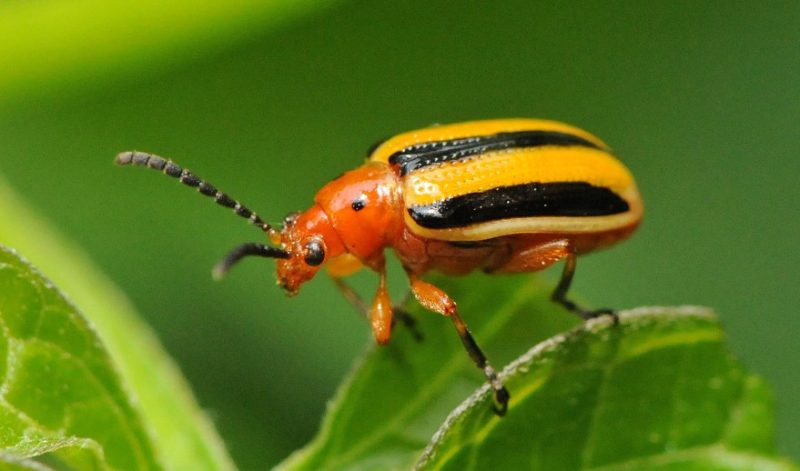
Three-lined potato beetles (Lema daturaphila) feature yellow, black, and white stripes with black antennae. Mainly affecting tomatillos, they also consume tomatoes and potatoes. These beetles grow up to 8 mm and are challenging to control by hand. As with many invasive species, effective control of three-lined potato beetles typically requires the use of pesticides.
Mottled Tortoise Beetle
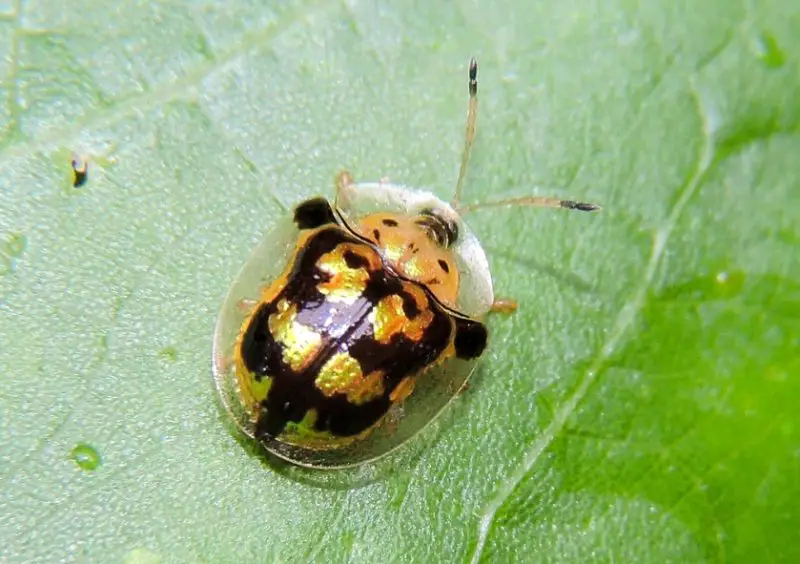
The Mottled Tortoise Beetle (Deloyala guttata) is a yellow beetle with black spots known for its color-changing ability. It starts with yellow coloring that turns golden-yellow as it matures. Common throughout North America in various species and subspecies, these beetles are abundant but not considered pests.
Elm Leaf Beetle
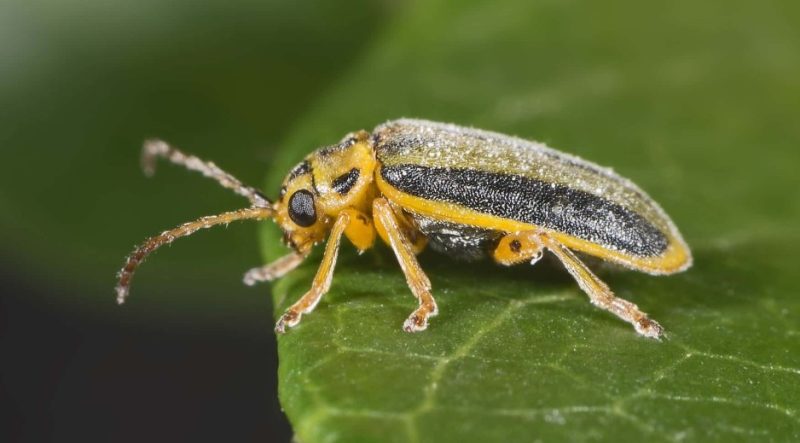
Elm Leaf Beetles (Xanthogaleruca luteola) are recognizable by their yellow pronotum and green-and-black elytra. They are significant pests of elm trees, causing considerable infestation levels. Initial signs of their presence include holes in elm leaves, leading to skeletonization where only the leaf veins remain. Native to North America, they thrive without natural predators. While they are also found in Europe and Australia, their damage in Europe is mitigated by predatory wasps.
Zebra Longhorn Beetle
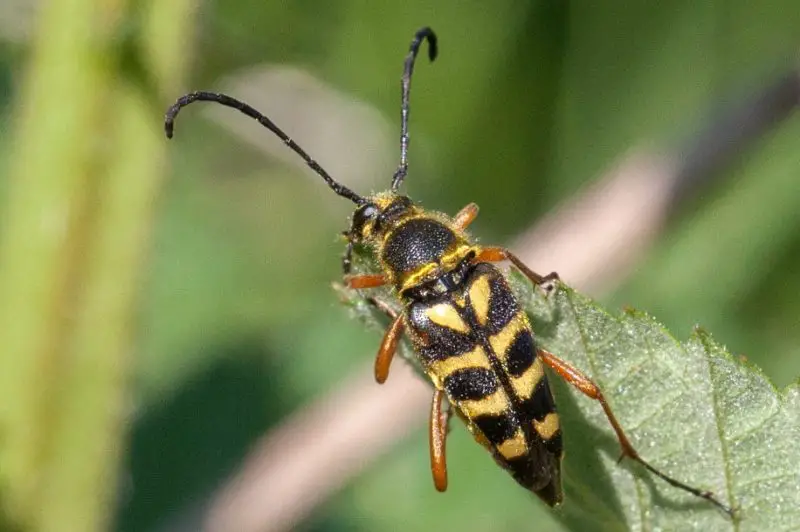
The Zebra Longhorn Beetle (Typocerus zebra) reaches a size of 16 mm and features distinctive black and yellow coloring. Its mostly black elytra display yellow triangles, bands, and stripes. This beetle is characterized by very long black antennae, up to half the length of its body, and legs that are either red or brown. Named for its alternating black and yellow elytra, this species is believed to mimic wasps as a form of defense against predators.
Squash Lady Beetle
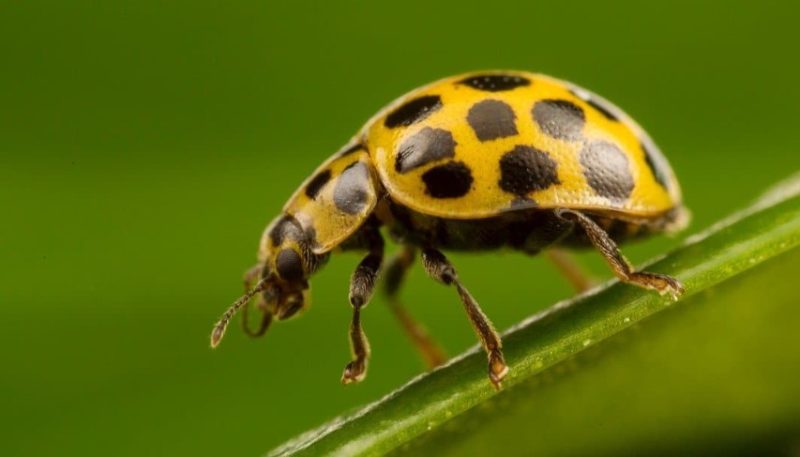
The Squash Lady Beetle (Epilachna borealis) resembles typical ladybugs with its black and yellow elytra. It primarily features yellow coloring with scattered black spots. This beetle is a pest commonly found on plants resembling cucumbers, particularly squash plants in the US. Hand removal is effective for controlling them in home gardens, while commercial growers often resort to pesticides to manage infestations on squash crops.
Yellow-Horned Flower Longhorn Beetle

The Yellow-horned Flower Longhorn Beetle (Strangalia luteicornis) is characterized by its black and dark yellow coloration. Found across the US, it plays a minor role as a pollinator. Both males and females are commonly sighted on swamp root flowers, where they feed on nectar, live, and mate. These beetles are attracted to the white flowers of Swamp root but do not change their color to match their host plant—a distinctive trait among black and yellow beetles.
Bean Leaf Beetle
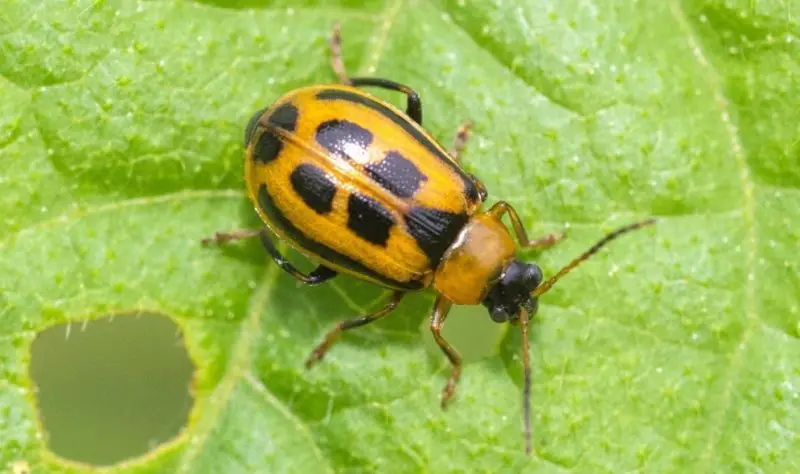
The Bean Leaf Beetle (Cerotoma trifurcata) is predominantly yellow with a yellow-black head and a few black spots on its elytra. In some regions, it may appear orange. This beetle is notorious for damaging various plants and vegetables, particularly beans. It feeds on bean leaves and lays eggs in bean and soybean seeds, posing a significant threat to crop yield. Due to the challenges of manual control, pesticides are commonly employed to manage bean leaf beetle populations.
Alligatorweed Flea Beetle
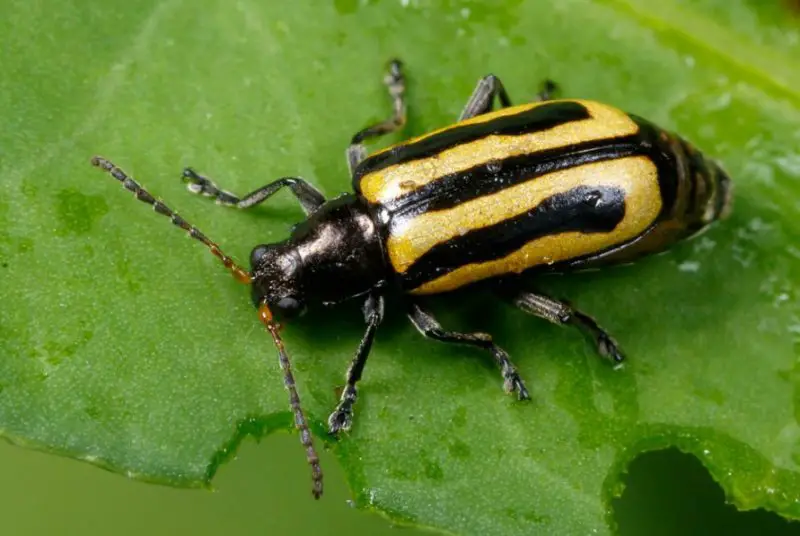
The alligatorweed flea beetle (Agasicles hygrophila) is a beneficial black and yellow beetle known for controlling the invasive alligatorweed. Recognizable by their striped bodies with alternating vertical black and yellow stripes, these beetles consume the leaves of alligatorweed plants. Found predominantly in the Southeastern US, their larvae are often observed on various plant leaves. After pupation, most beetles develop a yellow-black coloration, with some turning green-black. Adults are relatively small, reaching a maximum size of 7 mm.
Harlequin Flower Beetle
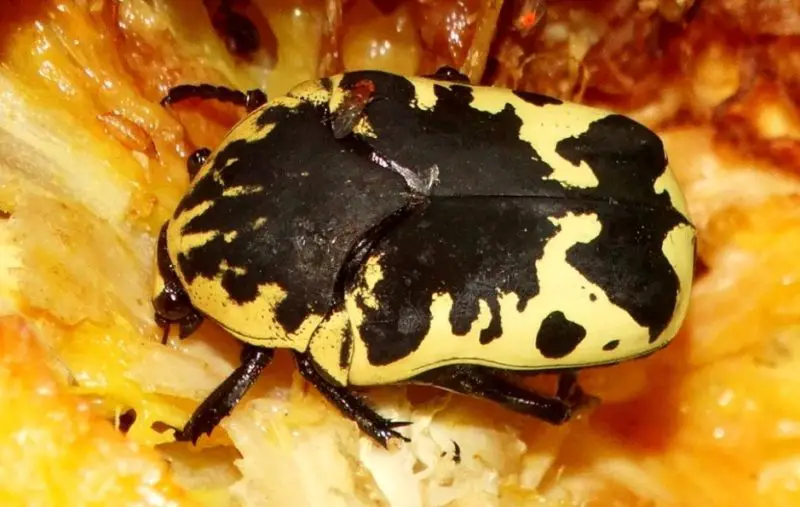
The Harlequin Flower Beetle (Gymnetis thula) can reach sizes up to 21 mm and is found in select territories across the Eastern United States. Males typically display a dominant black coloration, while females are predominantly yellow. These beetles primarily feed on plant sap and have adapted to drink leaking sap from tree trunks, often spending entire days consuming it. They are commonly observed on oak trees and are attracted to False willows as well.
Round-Necked Longhorn Beetle
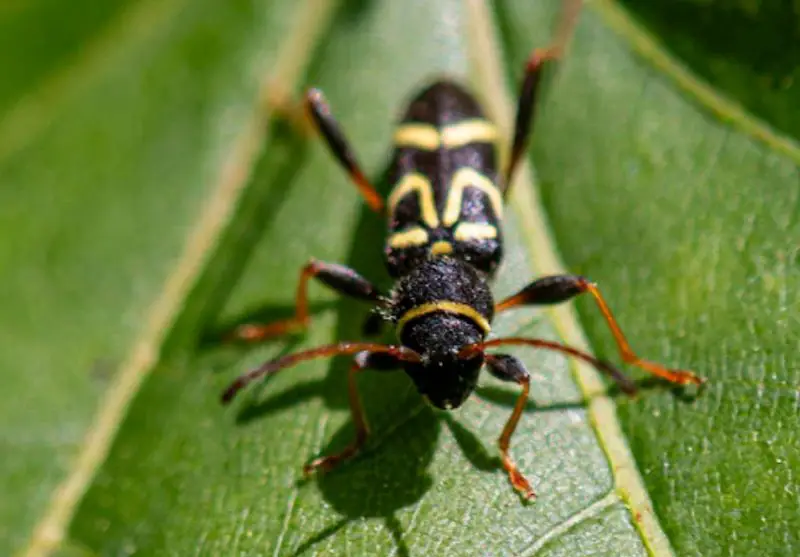
The Round-necked Longhorn Beetle (Clytus ruricola) features a black body with red legs and elytra marked with yellow lines and dots. Like other longhorn beetles, it possesses exceptionally long antennae that aid in navigation and sensing vibrations. Belonging to the Longhorn beetle family, it is occasionally mistaken for other beetle species due to its additional pair of legs. The antennae of this beetle can be longer than its body, distinguishing it further among similar-looking insects.
Painted Hickory Borer
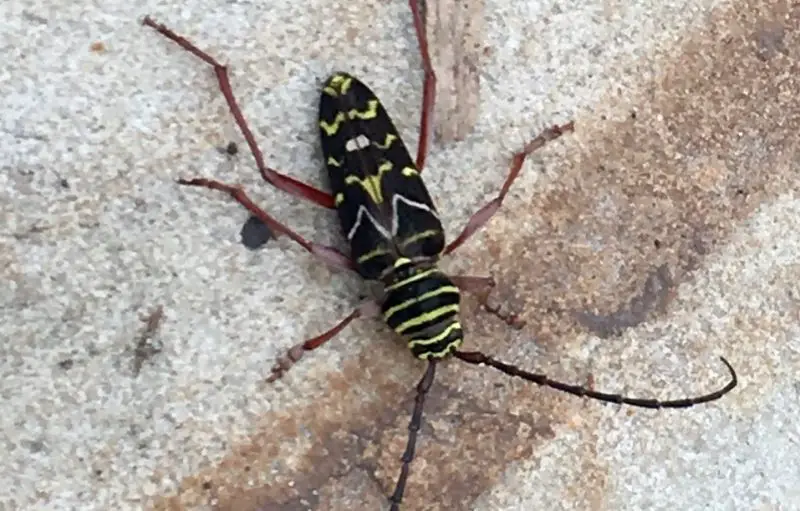
The Painted Hickory Borer (Megacyllene caryae) is a striking black and yellow beetle commonly found in Texas. Known for its vivid coloring, it features a dominant black body with distinct stripes running from head to elytra. These beetles serve as indicators of newly-dead hickory trees, as their larvae feed exclusively on dead hickory wood. Unlike other tree-specific borers, they consume a variety of dead hardwood. Adults typically reach sizes between 10 and 20 mm and emerge as early as March.
Judolia Cordifera
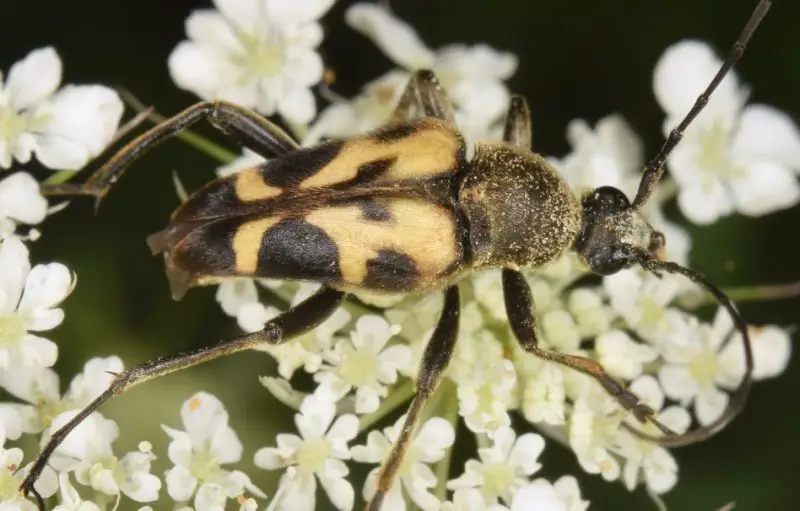
Judolia cordifera beetles are characterized by their black and yellow coloration, exclusive to this genus. Found in scattered locations across Eastern North America, their range is declining. Both larvae and adults feed on vegetation without being parasitic. Larvae specifically target chestnuts, while adults consume flower nectar. Despite their limited current threat level, their potential to become problematic in the future is heightened due to the endangered status of the American Chestnut, a favored food source for their larvae.
